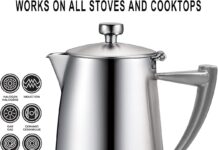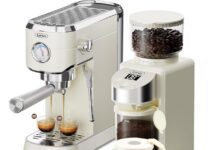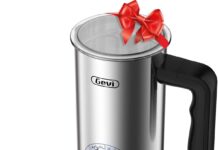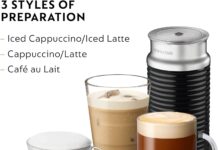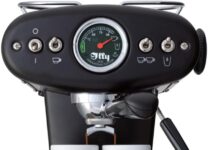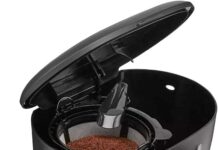Are you tired of brewing lukewarm coffee that fails to satisfy your desire for a piping hot cup of Joe? If you’re like us, the quest for the perfect brew is a never-ending pursuit of rich aromas and tongue-tickling warmth. In this article, we’re excited to share some simple yet effective tips to help you elevate your morning routine and achieve hotter, more satisfying coffee straight from your coffee maker. So put on your barista hat and get ready to savor each sip with delight!
Choosing the Right Coffee Maker
When it comes to choosing the right coffee maker, there are several factors to consider. The type of coffee maker plays a crucial role in determining the quality and temperature of the coffee it brews. Some popular types include drip coffee makers, espresso machines, French presses, and pour-over brewers. Each type has its unique brewing method and temperature control features, so it’s essential to choose one that aligns with your coffee preferences.
Consider the Type of Coffee Maker
Drip coffee makers are the most common and convenient type. They typically brew coffee by heating water and then allowing it to drip through a filter containing ground coffee. On the other hand, espresso machines use high pressure to force water through finely ground coffee, resulting in a concentrated and robust coffee flavor. French presses extract the coffee’s flavors by steeping coarsely ground coffee in hot water and then pressing the plunger to separate the liquid from the grounds. Pour-over brewers offer a more hands-on brewing experience, where hot water is poured over a filter containing coffee grounds in a controlled manner.
Look for Models with Higher Brewing Temperature
One factor that greatly affects the temperature of the brewed coffee is the brewing temperature of the coffee maker. Ideally, coffee should be brewed between 195-205°F (90-96°C) to extract its flavors optimally. So, it is essential to choose a coffee maker that can reach and maintain this temperature consistently. When researching coffee maker models, look for ones that have higher brewing temperature capabilities to ensure that your coffee comes out hot and flavorsome.
Check the Brewing Time
Another factor to consider is the brewing time of the coffee maker. The longer coffee is in contact with hot water, the more flavor it extracts. Therefore, it’s advisable to choose a coffee maker with a longer brewing time, as it allows the coffee to develop its flavors fully. This is particularly important if you prefer a stronger and more robust coffee taste. Some coffee makers offer customizable brewing time options, allowing you to experiment and adjust it according to your personal taste preferences.
Preparing for Brewing
Before you even start brewing your coffee, there are a few crucial steps to take to ensure the best possible outcome. These preparation steps can greatly impact the flavor and temperature of your coffee.
Clean the Coffee Maker Regularly
Regular cleaning of your coffee maker is essential for maintaining optimal performance and preventing the buildup of coffee residues. Over time, these residues can affect the taste of your coffee and even clog the machine. Cleaning the coffee maker is a simple process. Start by removing any used coffee grounds or filters. Then, wash the coffee carafe, filter basket, and other removable parts with warm soapy water. Some coffee makers even have a self-cleaning feature which can save you time and effort.
Preheat the Coffee Maker
Preheating the coffee maker helps to ensure that the brewing temperature is maintained throughout the process. Most coffee makers have a warming plate or a heating element that preheats the water before it comes into contact with the coffee grounds. Allow the coffee maker to heat up for a few minutes before adding the coffee to the machine. This will help to preserve the temperature of the coffee and ensure a hotter brew.
Use Freshly Ground Coffee Beans
Using freshly ground coffee beans is an easy way to elevate the flavor and aroma of your coffee. When coffee beans are ground, they release essential oils and volatile compounds that contribute to the overall taste experience. To get the most out of these flavors, it’s recommended to grind the beans just before brewing. This ensures that the maximum amount of flavor is extracted from the beans. Invest in a good quality burr grinder to achieve consistent and uniform grounds for the best results.
Using the Right Water
The quality and temperature of the water you use for brewing also play a significant role in the taste and temperature of your coffee. Follow these tips to optimize your brewing process and enhance your coffee’s overall flavor profile.
Consider Water Temperature
The temperature of the water used for brewing impacts the extraction of coffee flavors. As mentioned earlier, the ideal temperature range for brewing coffee is between 195-205°F (90-96°C). If the water is too hot, it can result in over-extraction and a bitter taste. Conversely, if the water is not hot enough, the coffee may taste weak and lack depth. To ensure the right water temperature, some coffee makers have built-in temperature control features. If not, you can manually heat the water to the desired temperature before adding it to the coffee maker.
Use Filtered Water
The quality of the water also affects the taste of the brewed coffee. Tap water can contain impurities and minerals that alter the flavor of the coffee. To mitigate this, consider using filtered water. Filtering the water removes any unwanted tastes and odors, resulting in a cleaner and purer cup of coffee. You can use a water filtration pitcher or attach a water filter to your tap for convenience.
Adjust the Coffee to Water Ratio
Finding the perfect coffee to water ratio is crucial for achieving a balanced and flavorful brew. The generally recommended ratio is 1:15 – 1:18, which means one part coffee to fifteen to eighteen parts water. However, this ratio can be adjusted according to personal preferences. Experiment with different ratios to determine the strength and concentration of coffee that suits your taste buds. Keep in mind that a higher coffee to water ratio will result in a stronger brew, while a lower ratio will produce a milder cup.
Optimizing the Brewing Process
To further enhance the quality and temperature of your brewed coffee, consider optimizing the brewing process itself. A few additional techniques can make a significant difference in the final result.
Pre-infusion or Bloom Phase
Pre-infusion, also known as the bloom phase, is a technique commonly used in pour-over brewing methods. It involves saturating the coffee grounds with a small amount of hot water before the actual brewing process begins. This allows the coffee to “bloom,” releasing trapped gases and enhancing the flavor extraction. If your coffee maker has a pre-infusion feature, take advantage of it to improve the quality of your brew.
Extend Contact Time
The contact time between water and coffee grounds during the brewing process affects the flavor extraction. To achieve a bolder and more robust coffee taste, consider extending the contact time. This can be done by adjusting the brewing time or using a slower brewing method, such as a French press. However, be cautious not to over-extract the coffee, as it can result in a bitter taste. It may take some trial and error to find the perfect balance that suits your taste preferences.
Covering the Coffee Pot
Covering the coffee pot during the brewing process can help retain heat and maintain the coffee’s temperature. This is particularly useful if you prefer to savor your coffee slowly or if you have a larger coffee pot that takes longer to finish. Simply place the lid on the coffee pot or use an insulated cover if available. By minimizing heat loss, you can ensure that each cup of coffee remains hot and satisfying.
Improving Thermal Insulation
Ensuring that your coffee stays hot for longer is essential for a pleasant and enjoyable coffee-drinking experience. Explore these methods to improve the thermal insulation of your coffee, keeping it hot from the first sip to the last.
Use a Thermal Carafe
Investing in a coffee maker with a thermal carafe can make a significant difference in maintaining the temperature of your coffee. Unlike glass carafes, thermal carafes are designed to insulate and retain heat for an extended period. They are typically made of stainless steel with a double-walled construction, which helps lock in the heat. As a result, your coffee will stay hot and fresh for hours without the need for a heat source.
Pre-warm the Coffee Mug
To ensure the longevity of your coffee’s warmth, pre-warm your coffee mug or cup before pouring the hot coffee into it. Simply rinse the mug with hot water, or let it sit on the warming plate of your coffee maker, if available. By doing so, you minimize heat loss when the hot coffee comes into contact with a cold mug, keeping the coffee at a higher temperature for a more extended period.
Avoid Leaving the Coffee Pot on the Coffee Maker
Leaving the coffee pot on the coffee maker’s heating plate for an extended period can lead to over-extraction and a decrease in the temperature and quality of the coffee. If you’re not planning to consume the entire pot immediately, transfer the remaining coffee to a thermal carafe or a separate container. This will help preserve the coffee’s temperature and prevent it from becoming bitter or stale.
Utilizing External Heat Sources
If you’re looking for additional ways to maximize the temperature of your coffee, consider utilizing external heat sources. These methods can provide an extra boost of warmth to your coffee-drinking experience.
Pre-warm the Coffee Cup with Hot Water
In addition to pre-warming the coffee mug, pre-warming the coffee cup with hot water can further assist in maintaining the coffee’s temperature. Fill the cup with hot water and let it sit for a minute or two. Then, discard the hot water and pour the freshly brewed coffee into the pre-warmed cup. The pre-warmed cup acts as an insulator and helps retain the coffee’s heat for longer.
Warm the Milk or Cream
If you enjoy adding milk or cream to your coffee, consider pre-warming them before adding them to the hot coffee. Cold milk or cream can quickly cool down the coffee, diminishing its overall temperature. By warming the milk or cream, you can avoid this temperature drop and enhance the overall warmth of your beverage. Heat the milk or cream in a separate container, such as a microwave or stovetop, and then add it to the coffee.
Use a Cup Warmer
If you frequently find yourself needing extra warmth in your coffee, investing in a cup warmer can be a game-changer. Cup warmers are small heating devices designed to keep your coffee mug or cup at a constant temperature. Simply place your mug on the warmer, and it will heat the bottom of the cup, preventing heat loss and ensuring a consistently warm cup of coffee.
Upgrading Your Coffee Maker
If you find that your current coffee maker isn’t meeting your expectations in terms of temperature or brewing options, it might be time to consider upgrading. There are several features and types of coffee makers that can offer more control and customization to suit your coffee preferences.
Invest in a Coffee Maker with Adjustable Temperature Settings
Some high-end coffee makers offer adjustable temperature settings, allowing you to customize the brewing temperature according to your preferences. This feature is particularly beneficial if you prefer hotter coffee or if you frequently experiment with different coffee beans and roast levels. By having the ability to control the temperature, you can ensure that your coffee is brewed precisely to your desired specifications.
Consider a Specialty Coffee Maker
If you are a coffee enthusiast or a connoisseur looking to take your coffee game to the next level, consider investing in a specialty coffee maker. These coffee makers are designed with advanced brewing techniques and precise temperature controls to bring out the best flavors from the coffee beans. Specialty coffee makers, such as those used for pour-over brewing or espresso machines, offer greater precision and customization options, allowing you to create the perfect cup of coffee every time.
Upgrade to a Siphon or French Press
If you prefer brewing methods that allow for more control over temperature and extraction, consider upgrading to a siphon or French press coffee maker. Siphon coffee makers use a vacuum-sealed brewing process, creating a cleaner and smoother brew. French presses, on the other hand, use immersion brewing, where the coffee grounds steep in hot water before being pressed down to separate the liquid from the grounds. Both methods provide a more hands-on and customizable brewing experience, resulting in a coffee with exceptional flavor and temperature.
Experiment with Different Techniques
For coffee lovers always looking to try something new, experimenting with different brewing techniques can be an exciting journey. These alternative methods can not only give you a unique coffee experience but also offer the opportunity to explore different flavor profiles and temperature options.
Try the Reverse Coffee Brewing Method
The reverse coffee brewing method, also known as the inverted method, is commonly used with AeroPress coffee makers. In this method, the coffee grounds and water are combined in the brewing chamber upside down, allowing for a longer steeping time. As a result, the coffee extracts more flavor and develops a bolder profile. The reverse method is a great way to achieve a hotter and more intense cup of coffee, ideal for those who enjoy a stronger brew.
Explore Cold Brewed Coffee
Cold brewing is a popular method for creating a smooth and low-acid coffee concentrate that can be enjoyed both hot and cold. By steeping coffee grounds in cold water for an extended period, typically 12-24 hours, the flavors are slowly extracted, resulting in a milder and less bitter taste. Cold brewed coffee can be reheated to your desired temperature, making it a versatile option if you prefer a cooler coffee or want to enjoy a cup hours after brewing.
Experiment with Pour Over Brewing
Pour-over brewing is a simple yet effective method for achieving a clean, flavorful, and temperature-controlled cup of coffee. It involves pouring hot water over a filter containing coffee grounds in a controlled and continuous manner. The slow and steady pour allows for better temperature control and ensures that the coffee grounds extract evenly. By experimenting with different pour-over techniques, such as water flow rate and pouring pattern, you can tailor your brew to your desired temperature and taste preferences.
Enhancing Coffee Flavor
In addition to temperature, the flavor of your coffee greatly contributes to the overall enjoyment of your cup. Here are a few tips to enhance the flavor of your coffee, resulting in a more satisfying and flavorful experience.
Select Dark Roast Coffee Beans
The roast level of your coffee beans can significantly impact the overall flavor profile. Dark roast beans, such as French roast or Italian roast, undergo a longer roasting process, resulting in a bold and intense flavor. These beans tend to have low acidity and a robust body, which can complement a hotter brewing temperature. If you prefer a stronger and more prominent coffee taste, opt for dark roast beans.
Consider the Coffee Bean Origin
Coffee beans from different regions and countries have their unique flavor characteristics. The climate, soil, altitude, and processing methods all play a role in shaping the flavor profile. Coffees from Africa, such as Ethiopian or Kenyan beans, are known for their fruity and floral notes. South American coffees, like Colombian or Brazilian beans, are often more balanced with nutty and chocolatey undertones. Exploring different coffee origins can help you discover new flavors and preferences.
Experiment with Different Grind Sizes
The grind size of your coffee grounds is a crucial factor in determining the flavor and extraction of your coffee. Finer grinds result in a faster extraction, producing a stronger and more concentrated brew. Conversely, coarser grinds extract more slowly, resulting in a smoother and milder cup. Experiment with different grind sizes to find the one that suits your taste preferences and brewing method. Adjusting the grind size can also influence the temperature of your coffee, as finer grinds expose more surface area to the hot water.
Additional Tips and Tricks
Here are a few bonus tips and tricks to help you make the most of your coffee brewing experience:
Preheat the Coffee Mug
If you want to ensure that your coffee stays hot from start to finish, preheating the coffee mug is a simple yet effective technique. By rinsing the mug with hot water before pouring the coffee, you can help maintain the temperature for a more extended period. It’s a small step that can make a significant difference in the overall enjoyment of your coffee.
Pour the Hot Coffee into a Pre-warmed Cup
Similar to preheating the coffee mug, pre-warming the cup you’ll be pouring the coffee into can help retain its temperature. Use hot water to warm the cup before transferring the freshly brewed coffee. By minimizing heat loss, you can prolong the warmth and enjoy a hot cup of coffee for longer.
Avoid Using a Coffee Warmer for Extended Periods
While coffee warmers can keep your coffee hot, it’s best to avoid leaving the coffee on the warmer for an extended period. Over time, prolonged exposure to heat can lead to over-extraction and a decrease in flavor quality. If you won’t be consuming all the coffee immediately, transfer it to a thermal carafe or separate container to maintain optimal temperature and taste.
In conclusion, achieving a hotter cup of coffee starts with choosing the right coffee maker and optimizing the brewing process. Consider the type of coffee maker that aligns with your preferences, ensuring it can achieve high brewing temperatures and provide longer contact time. Preparing for brewing by regularly cleaning the coffee maker, preheating it, and using freshly ground coffee beans can greatly enhance the flavor and temperature of your coffee. Utilize filtered water, adjust the coffee to water ratio, and consider additional techniques like pre-infusion and extending contact time to optimize the brewing process further. To keep your coffee hotter for longer, invest in a thermal carafe, pre-warm the coffee mug, and avoid leaving the coffee pot on the coffee maker. Utilizing external heat sources, such as pre-warming the coffee cup and milk, can also contribute to maintaining the coffee’s temperature. If you’re looking for an even hotter coffee experience, consider upgrading your coffee maker to one with adjustable temperature settings or explore specialty coffee makers like siphons or French presses. Don’t be afraid to experiment with different brewing techniques, coffee flavors, and grind sizes to discover your perfect cup of coffee. With these tips and tricks in mind, you’ll be well on your way to enjoying a hot, flavorful, and satisfying coffee experience every time.



